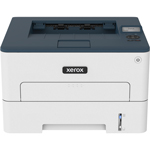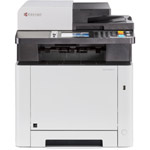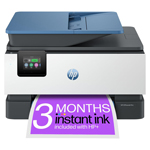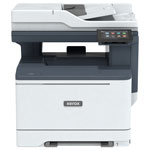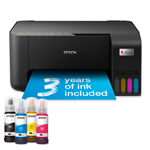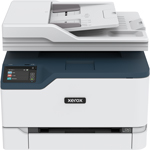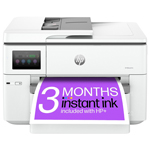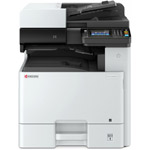In this guide, we've covered everything you need to know to pick the right printer for your chosen medium - from photography to cardstock, we've highlighted something for every type of user!
Read on below to find our expert suggestions for the best printers for different media types, or get in touch with a member of the Printerland sales team to discuss the options available to your business today.
Why do you need different printers for different media types?
A printer is just a printer, right? They're there for one purpose and one purpose only: printing.
Whilst that may be true to some degree, it's certainly not the full story and there's much more to consider than just the printer's ability to print out standard prints onto paper.
Of course, that may be exactly what you're after, in which case we've got a great collection of budget printers that are sure to give you excellent value for money, whilst producing plenty of great quality standard prints.
In this guide, however, we're going to be focusing on more unique media types.
We're going to be looking at printers that go beyond the capabilities of the standard printer, offering users the ability to print on many different types of material and media, such as cardstock, photographs, or even CDs!
If you're planning on printing on any of these materials, we'd encourage you to stick around...
What would happen if you use the wrong printer for your materials?
But first, let's look at the issues that could be caused by using the wrong type of printer to print on a unique media type.
First of all, you may find that you're simply unable to print on your chosen media type with a standard printer. If this is the case, you'll be halted in your tracks and forced to search for another way to print; that's not ideal if you're trying to meet a deadline.
The next issue that you might face is faults with your printer - each device is designed to be compatible with certain types of media and by using the wrong type of media in your printer, you could cause serious damage to your device.
If your device is damaged, you may be unable to print at all, leaving you without any printing solutions to make use of and a costly repair bill or the need to replace the printer entirely.
To avoid these additional costs, you need to ensure that the printer you're using is compatible with your media type. You'll find a list of the compatible media types in the user manual for your printer but if you're in doubt, be sure to get in touch with the manufacturer directly to ask the question - they'll be able to give you a clear answer before you potentially ruin an expensive piece of technology.
Here at Printerland, we understand that your printing needs might be outside of the norm - that’s why we’ve curated the wide range of printers in our catalogue! We’re looking to ensure that every user can find a printer that’s suitable for their needs, no matter how niche their needs are.
If you want to browse our full range of printers, you can head over to our online catalogue right here on the Printerland website - we’ve got laser printers, inkjet printers, A3 printers, and so much more in our collection, so we’re sure you’ll find something that’s a perfect fit for your intended usage.
The best printers for photographs
First up, we’re looking at printers for photography, which is one of the most popular niches on the market!
Printing photographs requires more delicacy and accuracy than you’d get from your average document printer, with brilliant visuals the biggest requirement, rather than cost-efficiency and speed as you’d expect with a document printer designed for the office.
Thankfully, there’s been a huge surge in demand for photo printers in recent years, which has resulted in an influx of high-quality photo printers being introduced to the market. It’s never been easier to find a great printer for printing photos!
No matter whether you’re looking to print in A4, A3, or large format, there’s a photo printer to suit everyone in every price range, but how do you know what to look out for?
Without in-depth knowledge of the printing industry, that’s probably a difficult question to try and answer, but don’t worry, our experts have provided you with the top things to look out for in a photo printer below!
What makes a printer suitable for printing photographs?
Before you start to look into the finer details of the printer’s specification, you need to check a few key functionality components first. If your printer doesn’t tick these boxes, it’s very unlikely that it’ll be a worthwhile investment as a photo printer.
Functionality is the most important aspect of any photo printer
The main functionality features that you’ll want to look out for are:
-
Colour printing capabilities - all good photos require a splash of colour, so you’ll want to ensure that your chosen printer features coloured ink or toner cartridges that allow you to print in vibrant colours.
- Different paper size compatibility - when you’re printing out your photos, you may want certain prints to be larger than A4, but to do so, you’ll need the best A3 printer that has multi-size compatibility.
- Multifunctionality - whilst your primary use for your printer may be printing out photos, you’ll probably want your printer to be able to double up as a functional office tool too. Colour Multifunction printers allow you to send faxes and emails as well as scan documents and photocopy as required, making the device a far more practical and cost-effective investment.
High-quality prints will make your photos pop
When you’re browsing through printers, you’ll probably notice that each printer can offer a certain level of resolution. The resolution that the printer is able to achieve will dictate the clarity of the print and, therefore, the overall quality of your photographs.
You may also want to consider the number of cartridges that the printer features - with more active cartridges, you’ll be able to achieve more depth and accuracy in your colours, which again will improve the quality of your print.
Look for high-resolution rates to ensure clarity in your photo prints
If you’re going to be printing photos professionally, you need to pay attention to the colour print resolution, which will be measured in DPI in the technical specifications of the printers that you’re considering.
DPI refers to the number of dots per inch that the printer will be able to produce, with high DPI printers being able to achieve more accurate, high-quality prints consistently.
Most inkjet printers will be able to produce prints at a minimum resolution of 600 x 600 dpi in black, and a whopping 4,800 x 1,200 in colour, guaranteeing crystal clear quality in every print you make.
It needs to fit within your budget
Whilst it’s great to look at the premium, top-of-the-range models, those aren’t always affordable, so you’ll want to ensure that you’re being realistic with your budget and setting your expectations accordingly.
If you’d like to check out the best printers for your budget click here!
The printer itself isn’t the only cost either; you’ll also need to budget for paper, ink or toner, and any software subscriptions that you might be using. All of these things contribute to your overall printing costs and you’ll need to budget for these to ensure that your making an affordable choice when committing to a printer.
Your level of usage will heavily dictate how often you need to plan on replacing your printing media and your ink/toner - frequent users may need to account for more supplies being used at a faster rate, whereas light to moderate users may be able to be more lenient on their supplies budget.
Consider the size and portability of your printer
Most of the time, you’ll probably be printing from your home or from the office, but there may be occasions when you may need to take your printer with you and print from a new location.
This is common for photographers who need to print on location, such as at events or functions such as weddings, conferences, or festivals. If you’ll be partaking in any of these activities, you’ll want to make sure that you’re choosing a printer that’s easy to move around and simply to recalibrate once you reach your destination.
Portable printers are available, as are mobile printers, but in most instances, these devices sacrifice print quality and favour portability instead - this may be okay for personal use, but if you’re printing professionally, you’ll need to maintain print quality at all costs. In our opinion, you should always choose to prioritise the quality of your printer and the prints that it creates over the size and portability that it offers, as these are secondary functions that are of additional benefit, rather than essential priority features.
The best printers for card
Printing on card is a popular function required in a professional environment.
From greetings cards through to more complex jobs such as mock-ups of box packaging, there are many reasons that you may need to print on heavy-duty materials, but this does mean that you’re going to require a specialist printer that’s capable of printing on high gsm materials.
For general cardstock, you’ve got far more options available to you when selecting a printer. Most printers that state they’re able to print up to 350gsm will be able to handle most common cardstock requests, such as business cards, greetings cards, and other light card-related designs.
However, it’s these more complex jobs where you’ll likely have to spend more time assessing the options and commit to a larger financial outlay. To print on these larger types of card, such as boxes and packaging, you’ll need a wide-format printer with a rear flat print path. This flat print path means that the printer does not need to bend the material when pulling it through to the delivery lasers, keeping the material in good condition as you print on it.
Here is a basic gsm guide to help you decide what your maximum gsm capacity needs to be to fit your needs:
- 40-110gsm - Tracing paper
- 40 - 55gsm - Newsprint paper
- 80gsm - Standard print paper used for documents
- 100-150gsm - Regular cardstock and promotional poster material
- 180-250gsm - Heavyweight drawing and art paper, and Bristol paper
- 300+gsm - Business cards, postcards, and study cards
You can find our range of cardstock printers at Printerland by clicking right here - you’ll discover a range of different maximum gsm printers to suit any purpose, so be sure to reference the gsm guide above to decide which level of gsm will work best for you!
The best printers for CD printing
Printing technology has been around for decades, but that doesn’t mean that it has stopped innovating and advancing. As a necessary piece of the modern home or office environment, the printer has adapted time and time again to provide modern solutions that remain relevant and practical in the present day.
One such innovation is the CD/DVD printer, which gives the user the ability to print onto modern media in the form of discs. At this point, we’re all familiar with the CD - it’s become a staple piece of modern media that’s used for storing music, videos, games, and software - they’ve been a revolutionary advancement that’s made storing digital media easier than ever.
But there’s always been a gap between the quality printing on store-bought discs and that which is found on homemade CDs and DVDs.
Until now, that is.
With a CD printer, you’ll be able to use inkjet or thermal printing technology to transfer designs onto a disc as if it were a sheet of paper - it’s incredibly easy and gives you professional-grade disc design in a matter of minutes!
As you’d imagine, being able to print onto a disc requires a very specific technological design that is vastly different to the everyday printer that you’d find in a corporate office or the average home. This means that you’ll need to invest in a specialist CD printer if you’re looking to print your designs onto this type of media.
The need to purchase an additional printer to print on CDs does mean that there’s an extra cost for printing onto discs, so you’ll want to consider how often you’ll be printing onto this media before making your investment.
If you’re expecting low use, purchasing an entirely new printer may not be the most financially astute choice, but for frequent users who will be printing discs in a professional capacity, a disc printer could be a prudent investment that allows you to keep production costs down as you create digital media products stored onto CDs or DVDs (CD-R or DVD-R).
The best printers for label printing
In general, if you wish to print labels, you must use a general-purpose printer rather than an all-in-one or a printer that is made for a different function than producing labels (e.g. Photo Printers). Because all-in-one printers are made to perform a variety of functions to an adequate standard rather than one particular function to an outstanding standard, their specifications are usually too limited to print labels to the standard that's required, if they can print labels at all.
A variety of hardware features and software programmes have been created for use when printing labels - these are usually included when purchasing your specialist label printer and you'll find instructions on how to utilise these in your user manual. Using these tools will help you to maximise your label print quality.
Labels are created from a range of materials and are naturally thicker than paper since they are made up of several layers of material. However, some printers will be restricted in the sorts and thicknesses of materials that they can accept and process efficiently. When printing a label, there are at least 3 layers of material that need to be processed, which are:
- Face material
- Adhesive
- Backing sheet
- Special coatings may also be used where appropriate
Find the right printing device for your needs with Printerland
Our experts have been in the printing industry for decades, giving us unrivalled experience and expertise when it comes to finding the right printers for any purpose, using any budget.
If you’re looking for a specialist printing device that can provide you with high-quality printing on your desired type of media, be sure to check out our category pages where we’ve identified our top picks for CD printing, cardstock printers, and photo printers respectively!
Alternatively, you can get in touch with our team by phone or by sending us an email at [email protected]. We’ll get back to you as soon as we can, but be aware that our printer experts are only available between 9:00 am and 5:30 pm Monday to Friday and all contact made outside of these times will be picked up the next business day.
Our guides will help you find the perfect printer
If you’ve enjoyed our guide to printers for different media types and would like to learn more about the best printers for different purposes, you’re in the right place - we’ve got guides relating to a number of the most popular types of printers, so we’re sure you’ll be able to find the advice and insight you need to find the perfect printer for your home or office!
You can find some of our most popular guides below:















